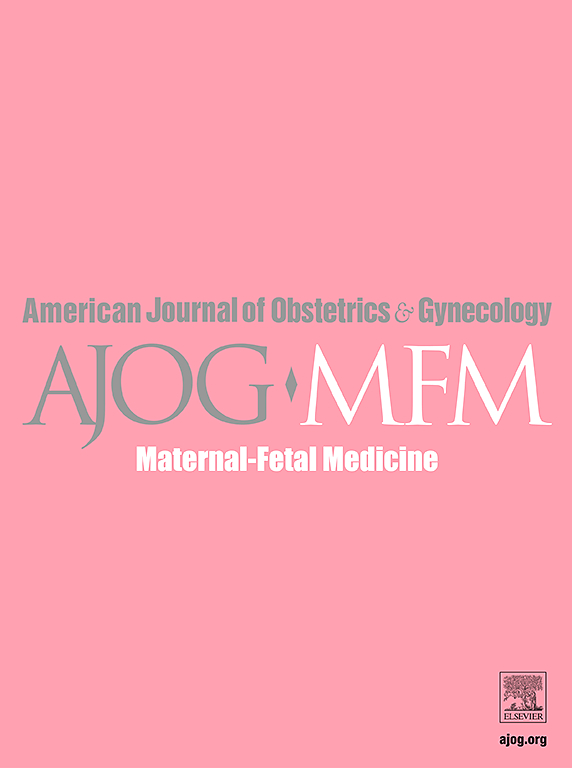The impact of an informative video on anxiety levels in women undergoing term induction of labor: a randomized controlled trial
IF 3.8
2区 医学
Q1 OBSTETRICS & GYNECOLOGY
American Journal of Obstetrics & Gynecology Mfm
Pub Date : 2025-03-15
DOI:10.1016/j.ajogmf.2025.101667
引用次数: 0
Abstract
Background
Induction of labor (IOL) is frequently performed worldwide. While IOL is often medically necessary to improve maternal and neonatal outcomes, the process can be associated with considerable anxiety, particularly for nulliparous women.
Objective
To evaluate the impact of an informative educational video on anxiety levels among women undergoing term IOL.
Methods
This randomized controlled trial included 167 women who underwent term IOL at a single medical center between April 2024 and August 2024. Participants in the “video group” (n=81) watched an 8-minute animated video detailing IOL methods and risks in addition to standard counseling. Participants in the control group (n=86) only received standard counseling. Anxiety levels were measured using the State-Trait Anxiety Inventory (STAI) before and after the procedure. The primary outcome was the change in STAI scores. Secondary outcomes including patient satisfaction, as reported on a scale of one to five.
Results
Baseline STAI scores before receiving any counseling regarding IOL were similar between the study groups. Postprocedure, women allocated to the video group demonstrated lower anxiety levels compared to women in the control group (38.9±11.0 vs 44.1±11.3, P=.002). Moreover, the decrease in STAI scores was greater in the video group (4.4±7.9 vs 0.6±10.0, P=.007). Multivariate analysis confirmed that the video intervention was independently associated with reduced anxiety (β –7.8, 95% CI –15.1 to –0.5). Finally, Patient satisfaction was also higher in the video group (4.4±0.6 vs 4.1±0.9, P=.018).
Conclusion
An informative educational video prior to IOL is an effective, low-cost intervention for reducing patient anxiety and improving satisfaction during labor induction.
一段信息视频对足月引产妇女焦虑水平的影响:一项随机对照试验。
背景:引产术(IOL)在世界范围内被广泛应用。虽然人工晶状体通常在医学上是改善孕产妇和新生儿结局所必需的,但该过程可能与相当大的焦虑有关,特别是对未生育的妇女。目的:评价一段教育性视频对足月引产(IOL)妇女焦虑水平的影响。方法:这项随机对照试验包括167名于2024年4月至2024年8月在同一医疗中心接受了人工晶状体植入术的妇女。“视频组”的参与者(n=81)观看了一段8分钟的动画视频,详细介绍了人工晶状体的方法和风险,以及标准的咨询。对照组(n=86)只接受标准咨询。在手术前后使用状态-特质焦虑量表(STAI)测量焦虑水平。主要结果是STAI评分的变化。次要结果包括患者满意度,以1到5的等级报告。结果:在接受任何有关IOL的咨询之前,实验组之间的基线STAI评分相似。术后,与对照组相比,视频组的女性表现出较低的焦虑水平(38.9±11.0 vs 44.1±11.3,p=0.002)。此外,视频组的STAI评分下降幅度更大(4.4±7.9 vs 0.6±10.0,p=0.007)。多变量分析证实,视频干预与焦虑减少独立相关(β -7.8, 95% CI -15.1至-0.5)。最后,视频组患者满意度也更高(4.4±0.6 vs 4.1±0.9,p=0.018)。结论:人工晶状体术前教育视频是一种有效的、低成本的干预措施,可减少患者的焦虑,提高引产过程的满意度。
本文章由计算机程序翻译,如有差异,请以英文原文为准。
求助全文
约1分钟内获得全文
求助全文
来源期刊

American Journal of Obstetrics & Gynecology Mfm
Medicine-Medicine (all)
CiteScore
7.40
自引率
3.20%
发文量
254
审稿时长
40 days
期刊介绍:
The American Journal of Obstetrics and Gynecology (AJOG) is a highly esteemed publication with two companion titles. One of these is the American Journal of Obstetrics and Gynecology Maternal-Fetal Medicine (AJOG MFM), which is dedicated to the latest research in the field of maternal-fetal medicine, specifically concerning high-risk pregnancies. The journal encompasses a wide range of topics, including:
Maternal Complications: It addresses significant studies that have the potential to change clinical practice regarding complications faced by pregnant women.
Fetal Complications: The journal covers prenatal diagnosis, ultrasound, and genetic issues related to the fetus, providing insights into the management and care of fetal health.
Prenatal Care: It discusses the best practices in prenatal care to ensure the health and well-being of both the mother and the unborn child.
Intrapartum Care: It provides guidance on the care provided during the childbirth process, which is critical for the safety of both mother and baby.
Postpartum Issues: The journal also tackles issues that arise after childbirth, focusing on the postpartum period and its implications for maternal health. AJOG MFM serves as a reliable forum for peer-reviewed research, with a preference for randomized trials and meta-analyses. The goal is to equip researchers and clinicians with the most current information and evidence-based strategies to effectively manage high-risk pregnancies and to provide the best possible care for mothers and their unborn children.
 求助内容:
求助内容: 应助结果提醒方式:
应助结果提醒方式:


